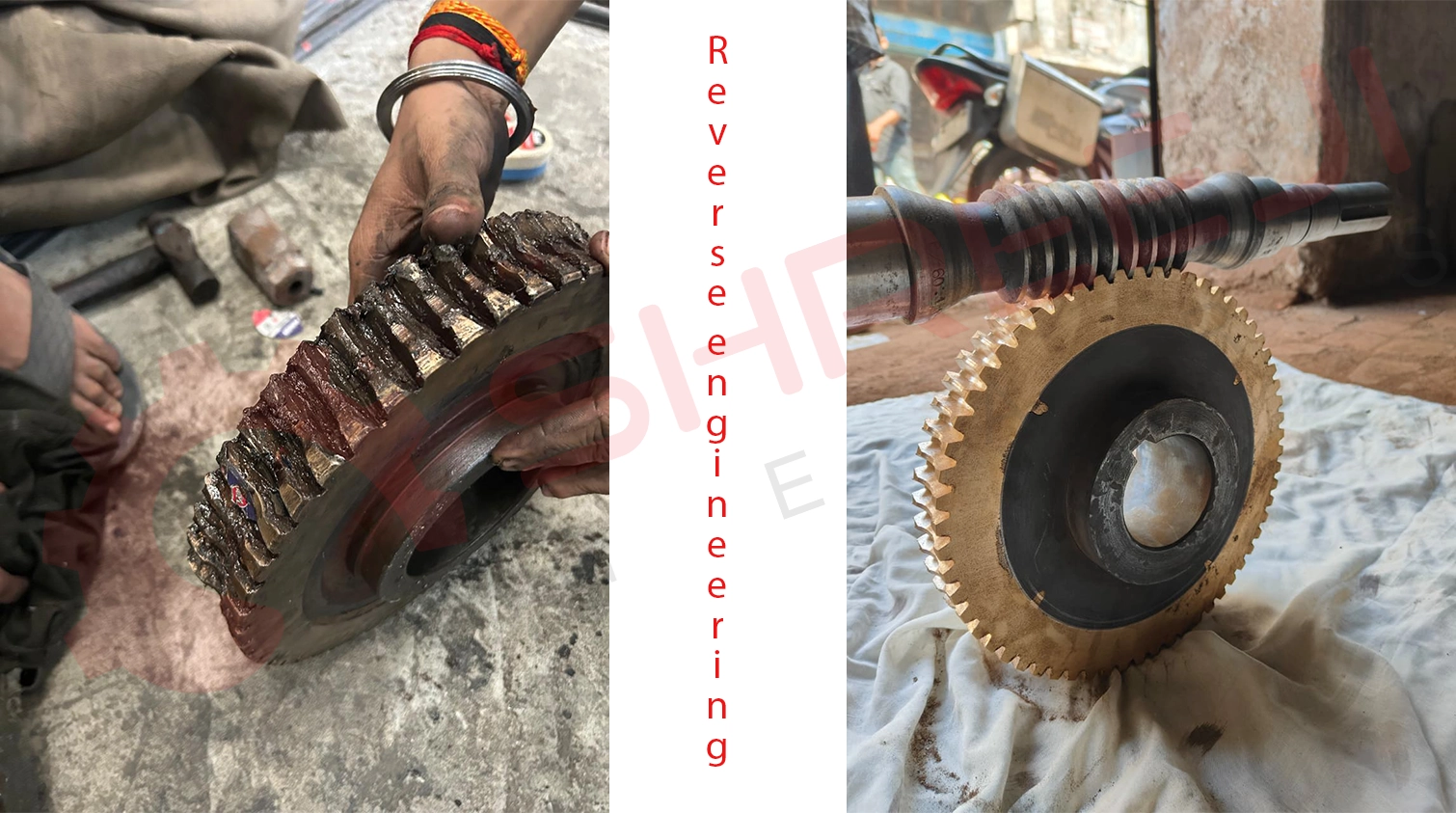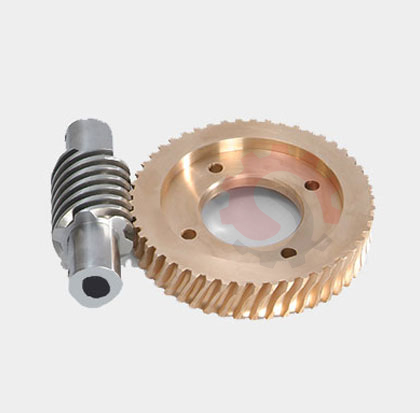Worm Gear Manufacturer, Supplier & Exporter
- Home
- Worm Gear
Worm Gears Manufacturer, Supplier & Exporter
Engineered for compact, right-angle power transmission, our worm gears provide high reduction ratios and inherent self-locking safety.
- High Reduction Ratios (Up to 100:1)
- Self-Locking for Safety & Control
- Quiet, Smooth Right-Angle Drive
- Hardened Steel & Bronze for Longevity
Manufacturing Specifications
We manufacture worm gear sets as matched pairs to ensure optimal contact, efficiency, and service life. The worm is a screw-like gear, conceptually similar to the gear used in our rack and pinion systems for linear motion.
| Worm (Screw) Specifications | |
|---|---|
| Material | Alloy Steels (EN353, 20MnCr5) |
| Heat Treatment | Case Carburized, Hardened & Tempered |
| Hardness | 50-58 HRC |
| Manufacturing | Thread Milling or Grinding for high precision |
| Starts | Single, Double, or Multi-start designs available |
| Worm Wheel Specifications | |
| Material | Phosphor Bronze (PB1, PB2), Aluminium Bronze, Cast Iron (CI FG260) |
| Manufacturing | Precision hobbing on specialized machines |
| Configuration | Solid, spoked, or with a steel hub and bronze rim |
Key Industrial Applications
Worm gears are the preferred solution where high reduction, load-holding, or compact design is essential:
- Conveyor Systems: For controlled, high-torque movement and braking.
- Lifts & Hoists: Leveraging the self-locking feature for critical safety.
- Indexing & Rotary Tables: For precise, repeatable positioning in machine tools.
- Material Handling Equipment: Providing compact, powerful drives for moving heavy loads.
- Automated Gate Operators
- Packaging Machinery
- Pressing Machines
- Rudder Control Systems
Comparison: Worm Gear vs. Bevel Gear
Both are right-angle drives, but they serve very different purposes. Here’s a quick guide to help you choose.
| Feature | Worm Gear Set | Bevel Gear Set |
|---|---|---|
| Gear Ratio | Very High (10:1 to 100:1+) | Low (Typically 1:1 to 5:1) |
| Self-Locking | Yes (by design) | No |
| Efficiency | Lower (50-90%) | High (95-99%) |
| Heat Generation | High (due to sliding) | Low (due to rolling) |
| Backlash | Moderate to High | Very Low (with spiral bevel) |
| Ideal Use | High reduction, load holding | High efficiency, precision power transfer |
Frequently Asked Questions
A worm gear is a compact gear system where a screw-like worm meshes with a wheel to provide high reduction ratios and smooth, quiet power transmission.
The primary advantage is achieving very high speed reduction in a single stage, such as 20:1, 50:1, or even 100:1, which would require multiple gear stages with other gear types.
Self-locking means the worm wheel cannot back-drive the worm. This prevents reverse motion and acts as a safety brake in lifts, hoists, and conveyors.
The worm is hardened steel for strength, and the wheel is bronze to reduce friction and wear, acting as a sacrificial component for protection.
They are used in elevators, hoists, conveyors, steering systems, packaging machines, automation systems, and material handling equipment.
Yes. Worm gears produce very high torque due to their high reduction ratios.
They operate through sliding contact instead of tooth impact, making them smoother and quieter.
Yes, high-viscosity lubricants such as ISO 460–680 oils are needed to maintain film strength under sliding friction.
Efficiency ranges from 40% to 90%, depending on load, lubrication, and ratio. Lower ratios typically offer better efficiency.
Most cannot due to self-locking characteristics, but low-ratio or high-lead designs may allow limited back-driving.
Proper lubrication, load, temperature, alignment, and the material pairing all affect lifespan.
They can be made of phosphor bronze, brass, aluminum bronze, cast iron, steel, or engineering plastics depending on the load requirements.
Typical ratios range from 10:1 to 100:1, with custom builds exceeding 300:1 for special applications.
India has many capable worm gear manufacturers. The right choice depends on material options, machining accuracy, customization, and experience.
Yes, Shreeji Gears produces precision worm gears and worm wheel sets with custom materials, sizes, and high-accuracy machining for industrial applications.
Worm Gear Technical Drawing Example
We manufacture precision-engineered worm gears and worm wheels based on detailed technical drawings, ensuring exact accuracy in lead angle, module, number of starts, pitch diameter, center distance, and material specifications. We also accept sample-based manufacturing through reverse engineering when drawings are not available.

The Shreeji Gears Advantage: Engineering for Reliability
We go beyond manufacturing to deliver worm gear sets that are robust, safe, and built to last.
The Art of Material Pairing
A successful worm drive depends on the synergy between the worm and wheel. We pair case-hardened, ground-finish steel worms with high-quality phosphor bronze wheels. This combination minimizes friction, manages heat, and ensures the gear set wears predictably for a long, reliable service life.
Precision in Every Thread
The worm's profile is not just a screw; it's a precision-engineered gear tooth. Our CNC thread grinding and milling processes create a perfectly formed worm profile. We then hob the wheel to be a perfect conjugate, ensuring a full-contact patch for maximum torque transfer and smooth operation.
Engineered Safety & Control
The self-locking feature is not an accident; it's a result of precise engineering. We control the lead angle of the worm to design a gear set that is either self-locking for safety or back-drivable for specific applications. You get the exact performance characteristics your system requires.
Worm Gears Manufacturer, Supplier & Exporter : High Reduction & Reliability
When to Specify a Worm Gear
Worm gears, consisting of a worm (screw) meshing with a worm wheel (gear), are widely used for applications requiring very high reduction ratios in compact spaces. Their unique sliding action delivers smooth motion, quiet operation, and in some cases, a natural self-locking ability. Here’s when to choose a worm gear:
- High reduction in a compact system: Worm gears can achieve massive reduction ratios in a single stage, making them ideal where space is limited but high torque is needed.
- Self-locking capability is required: Depending on the lead angle, worm gears can naturally prevent back-driving, eliminating the need for external brakes in safety-critical applications.
- Low noise, smooth operation: The sliding contact of worm and wheel teeth provides vibration-free and silent running, which is essential in elevators, conveyors, and precision equipment.
- Shock load resistance: Worm gears have excellent shock-absorbing ability, making them a trusted choice for heavy-duty machinery and load-handling systems.
Managing Friction & Efficiency in Worm Gears
While worm gears are highly effective, their sliding tooth contact generates more friction and heat compared to rolling contact gears like helical gears. This makes proper material pairing (typically hardened steel worm with a bronze wheel) and efficient lubrication crucial for long life and optimal performance. With correct design, material selection, and maintenance, worm gears deliver exceptional durability in demanding environments.
Shreeji Gears: The Leading Manufacturer of Worm Gears
At Shreeji Gears, we specialize in the production of custom worm gears and worm gearboxes tailored to your application. Our worm gears are trusted across industries for their high reduction capabilities, smooth transmission, and self-locking safety benefits. With advanced manufacturing technology and years of expertise, we deliver gears that meet the toughest performance standards worldwide.
Why Choose Shreeji Gears?
- Precision Manufacturing: Using advanced machining and heat treatment, we produce high-precision worm gears that ensure smooth operation and long service life.
- Expertise in High Reduction Design: Our engineers can customize worm gear designs for specific reduction ratios, torque levels, and safety requirements, including self-locking systems.
- Pan-India Distribution Network: We supply worm gears across all major industrial hubs including Gujarat, Maharashtra, Karnataka, Tamil Nadu, and more, ensuring fast and reliable delivery.
- Global Exporter: Beyond India, our worm gears are exported to international markets, manufactured in compliance with strict global standards.
- Customer-Centric Service: From design consultation to on-time delivery, we focus on providing tailored solutions and full technical support for every customer.
Serving Major Industrial Hubs Across India
We serve a wide variety of industries including industrial gearboxes, material handling equipment, conveyors, lifts, and automotive systems. Our supply network spans across:
- Gujarat (Ahmedabad, Rajkot, Vadodara, Surat)
- Maharashtra (Mumbai, Pune, Nagpur)
- Karnataka (Bangalore, Mysore)
- Tamil Nadu (Chennai, Coimbatore)
- Telangana (Hyderabad)
- Delhi NCR (Noida, Faridabad, Gurugram)
- Punjab (Ludhiana, Jalandhar)
- Rajasthan (Jaipur, Udaipur)
- Madhya Pradesh (Indore, Bhopal)
- West Bengal (Kolkata)
- Odisha (Bhubaneswar)
- Kerala (Kochi)
- Uttar Pradesh (Kanpur, Lucknow, Ghaziabad)
- And many more...
Whether your requirement is for precision worm gears in automation or heavy-duty worm gearboxes in material handling, Shreeji Gears delivers durable, high-performance solutions across India and worldwide.
Get a Quote for Your Custom Worm Gear Set
Provide your technical specifications for a fast and accurate quote from our engineering team.
For the quickest service, please email your engineering drawing or a sketch to support@shreejigears.com. Please include these key parameters in your inquiry:
- Required Gear Ratio (e.g., 40:1)
- Center Distance between worm and wheel
- Number of Starts on the worm (1, 2, 4 etc.)
- Material & Hardness for both Worm and Wheel
- Bore/Shaft Diameters and Keyway sizes
- Required Quantity
Stay Updated with Our Latest News
Subscribe to get the latest updates, offers & insights from Shreeji Gears!

